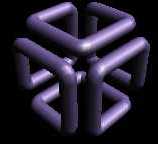


 |

|

|
Home | | Syllabus | |
Assignments | |
Documentation
Solution to Assignment 7
Problem 1: (xmin, ymin) = (50, 50); (xmax, ymax) = (150, 100)
b1 = 1 if y < ymin b2 = 1 if x > xmax b3 = 1 if x < xmin Case 1: if o0 = o1 = 0 we render the entire line. Case 2: if o0 = 0 and o1 != 0 (or vice versa) we must clip Case 3: if o0 & o1 != 0 discard the entire line Case 4: if o0 & o1 = 0 we may or may not have to clip, depending on intersections. a) P0 = (25, 75), outcode o0 = 0001; P1 = (30, 125), outcode o1 = 1001 Because o0 & o1 = 0001 is not zero, the line is discarded. b) P0 = (100, 70), outcode o0 = 0000; P1 = (125, 120), outcode o1 = 1000 o0 & o1 = 0; o0 = 0, o1 != 0; Therefore we need to clip. delta_y / delta_x = (y1 - y0) / (x1 - x0) =(120 - 70) / (125 - 100) = 2 Intersection at top border (ymax = 100):
Values of x and y at clipped point: (115, 100) c) P0 = (100, 25), o0 = 0100; P1 = (175, 75), o1 = 0010 o0 & o1 = 0, we must compute intersections to determine whether clipping is needed. Intersections are computed as for part b. Intersection with lower border (y = 50) occurs at x = 137.5, Intersection with right border (x = 150) occurs at y = 58.33, These intersections are within the boundary of the clipping rectangle, so we must clip.
Problem 2: Liang-Barsky clipping. We use the same clipping boundaries as in problem 1. P1 = (30, 80); P2 = (90, 110) Parametric representations:
y = y1 + alpha(y2 - y1); y = 80 + alpha(30)
Negative pk's: p1 and p3. Positive pk's: p2 and p4. u1 < u2 so we must clip at alpha = u1 and alpha = u2. (x, y) values at alpha = u1 = 1/3:
y = 80 + alpha(30) = 80 + (1/3)(30) = 90 (x, y) values at alpha = u2 = 2/3:
y = 80 + (2/3)(30) = 100 Therefore we clip at (50, 90) and (70, 100)
Problem 3: Line drawing a) Use DDA algorithm to draw a line between Slope of line = delta_y/delta_x = (8 - 3)/(9 - 2) = 5/7 First point: x = 2, y = 3 Second point: x = 3, y = 3+5/7; Plot (3, 4) Third point: x = 4, y = 3 + 10/7 = 4 + 3/7; Plot (4, 4) Fourth point: x = 5, y = 4 + 8/7 = 5 + 1/7; Plot (5, 5) Fifth point: x = 6, y = 5 + 6/7; Plot (6, 6) Sixth point: x = 7, y = 5 + 11/7 = 6 + 4/7; Plot (7, 7) Seventh point: x = 8, y = 6 + 9/7 = 7 + 2/7; Plot (8, 7) Eigth point: x = 9, y = 7 + 7/7 = 8; Plot (9, 8)
b) Use the Liang-Barsky algorithm to draw a line between
First, compute values:
First, Plot (x1, y1) = (2, 3) At each step, if pk < 0, then
p(k+1) = pk + 2*delta_y = pk + 8 If pk > 0 then
p(k+1) = pk + 2*delta_y - 2*delta_x = pk - 4.
Therefore, we plot pixels at:
Home | | Syllabus | | Assignments | | Documentation
Constance Royden--croyden@mathcs.holycross.edu
|